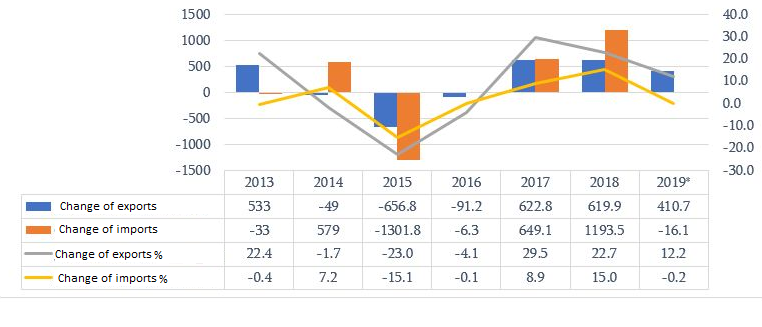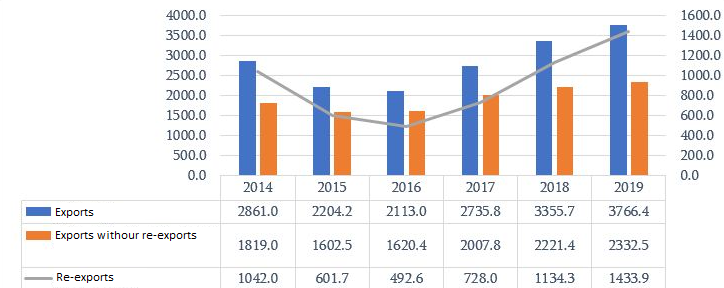Resume: Although exports in the last years have a growth tendency, import figures are also increasing annually and as a result of the trade deficit; that is, the difference between exports and imports does not shrink significantly and fluctuates from nearly USD 5.7 billion to USD 5.1 billion. As of 2019’s data, the export of goods was valued USD 3.7 billion whilst import was USD 9.1 billion. Therefore, the trade deficit constituted USD 5.3 billion which is a not a historic low either in absolute or in relative figures. In absolute figures, the trade deficit in 2013, 2015 and 2017 was lower as compared to 2019 whilst the trade deficit to GDP ratio was lower in 2013.
In addition, whilst discussing percentage changes it is important to take the base effect into account. In particular, since the absolute figure for import is several times higher as compared to the absolute figure for export, changes in the absolute figures for import would be less in percentage as compared to export. For instance, export increased by GEL 720 million in 2018 whilst import increased by GEL 1.2 billion. In percentages, export increased by 22.7% and import increased by 15.7%. Naturally, the high percentage the growth in export is indicative of certain success, although it is an irrelevant figure whilst analysing the trade deficit and the trade balance to GDP ratio.
Speaking about export figures, it is also important to distinguish the share of re-export in the total export. Other things being equal, the growth of export causes the growth of the gross domestic product. The effect of export goods production is also reflected in other components, employment increases and revenues are generated. Re-export has lesser influence over job creation and the growth of production which needs to be taken into account whilst analysing export. In 2019, the growth of export without re-export was comparably insignificant and constituted USD 126 million which is a 5% growth vis-à-vis a 12% growth. In this regard, the previous years were more successful and, consequently, the share of export in economic growth was more effective.
Analysis
The Minister of Economy and Sustainable Development, Natia Turnava, on air on TV PalitraNews stated (26:40): “Import dependency has decreased. In 2019, the trade deficit was at a historic low and our trade balance showed a maximal improvement because export increased significantly by 12%.”
Historically, import in Georgia significantly exceeds export which makes the country’s economy rather vulnerable, especially under the sharp volatility of the currency exchange rate. The fact that of the bulk of Georgia’s main export groups constitutes basically raw materials (copper ore and ferro-alloys) and the export of cars is in fact a re-export is indicative of conjectural vulnerability.
Although exports in the last years have a growth tendency, import figures are also increasing annually and, as a result the trade deficit; that is, the difference between exports and imports does not shrink significantly and fluctuates from nearly USD 5.7 billion to USD 5.1 billion.
As of 2019’s data, the export of goods was valued USD 3.7 billion whilst import was USD 9.1 billion. Therefore, the trade deficit constituted USD 5.3 billion which is not a historic low either in absolute or in relative figures. In absolute figures, the trade deficit in 2013, 2015 and 2017 was lower as compared to 2019 whilst the trade deficit to GDP ratio was lower in 2013.
Table 1: Foreign Trade Figures in 2012-2020 (USD Million)
|
2012 |
2013 |
|
2014 |
2015 |
2016 |
2017 |
2018 |
2019 |
2020 (4 Months) |
|
|
Registered Export of Goods (FOB) |
2,377 |
2,910 |
|
2,861 |
2,204 |
2,113 |
2,736 |
3,356 |
3,766 |
1,001 |
|
Registered Import of Goods (CIF) |
8,056 |
8,023 |
|
8,602 |
7,300 |
7,294 |
7,943 |
9,137 |
9,120 |
2,462 |
|
Trade Deficit |
-5,679 |
-5,113 |
|
-5,741 |
-5,096 |
-5,181 |
-5,207 |
-5,781 |
-5,354 |
-1,461 |
|
Trade Deficit to GDP Ratio (%) |
-34,4 |
-29,7 |
|
-32,6 |
-34,1 |
-34,2 |
-32,0 |
-32,9 |
-30,2 |
Source: National Statistics Office of Georgia
In addition, whilst discussing percentage changes, it is important to take the base effect into account. In particular, since the absolute figure for import is several times higher as compared to the absolute figure for export, changes in the absolute figures for import would be less in percentage as compared to export. For instance, export increased by GEL 720 million in 2018 whilst import increased by GEL 1.2 billion. In percentages, export increased by 22.7% and import increased by 15.7%. Naturally, the high percentage growth of export is indicative of certain success, although it is an irrelevant figure whilst analysing the trade deficit and the trade balance to GDP ratio.
Graph 1: Absolute and Percentage Dynamic of Export and Import Change (USD Million, %)

Source: National Statistics Office of Georgia
Speaking about export figures, it is also important to distinguish the share of re-export in the total export. Other things being equal, the growth of export causes the growth of the gross domestic product. The effect of export goods production is also reflected in other components, employment increases and revenues are generated. Re-export has a lesser influence over job creation and the growth of production which needs to be taken into account whilst analysing export. Re-export is not a negative thing in itself and the growth of re-export is considered as a positive change. However, the total profit from re-export for a country is naturally less as compared to export. Therefore, the growth of re-export in itself is welcoming although undesirable when its size is large in the structure of export. In 2019, the growth of export without re-export was comparably insignificant and constituted USD 126 million which is a 5% growth vis-à-vis a 12% growth. In this regard, previous years were more successful and, consequently, the share of export in economic growth was more effective.
Graph 2: Export and Re-export Dynamic

Source:National Statistics Office of Georgia








